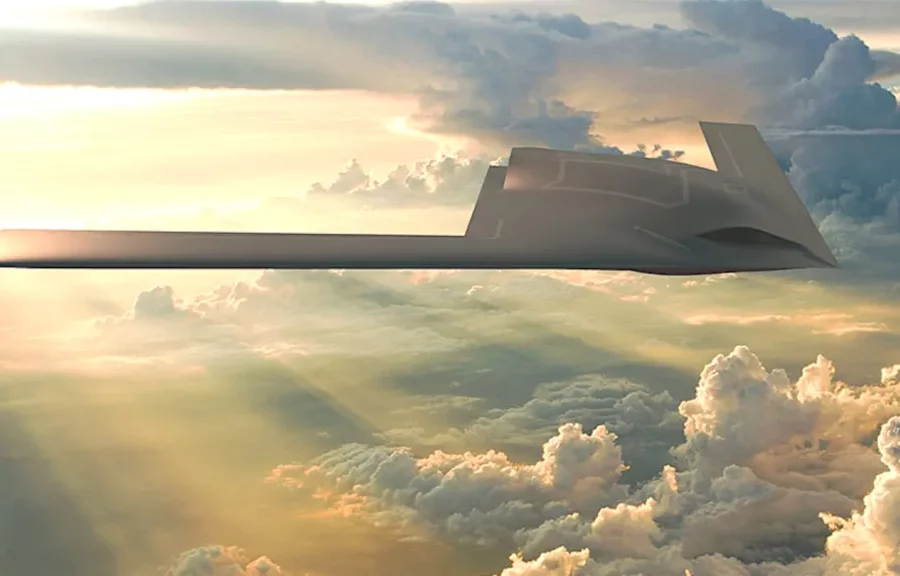Drone manufacturer General Atomics is developing an autonomous, stealthy, penetrating, ultra-long-endurance flying-wing reconnaissance and strike platform for the Air Force under a $99.3 million Air Force Research Laboratory contract awarded May 27.
The cost-plus-fixed-fee award is for an aircraft to be powered by “hybrid-electric propulsion” and use a ducted fan. The aircraft is intended to be a “next-generation intelligence, surveillance, reconnaissance/strike” platform, with “capabilities across a spectrum of contested environments,” the Air Force said. The service has termed the plane the “GHOST,” without explaining what the acronym means. The contract was a sole-source acquisition, AFRL said.
GA is to perform the work at its Poway, Calif., facilities by August 2028, according to the Pentagon.
A General Atomics spokesperson referred all queries to the Air Force and AFRL, neither of which provided an immediate response.
The Air Force didn’t say what requirement the GHOST is intended to fill, but the service plans to retire the venerable U-2 Dragon Lady crewed ISR aircraft starting in 2026. The Air Force originally had planned to replace the U-2 with the RQ-4 Global Hawk, but has been drawing down the inventory of that aircraft in recent years and plans to retire all variants by the end of 2027. The Air Force is believed to be operating an ultra-stealthy RQ-180 long-range ISR platform built by Northrop Grumman, but the service has repeatedly declined to provide any information on that program.
However, neither the U-2 nor the RQ-4 has a kinetic strike mission, as the GHOST seems slated for. It may instead be a descendant of a planned “MQ-X” program—a stealth version of the MQ-9 Reaper—which the Air Force has pulled in and out of the budget for at least 10 years.
General Atomics showed a photo of a flying-wing-type ISR aircraft at its booth at the 2022 AFA Air, Space & Cyber conference. GA Aeronautical Systems president David Alexander, in two appearances on the “Tomorrow’s World Today” podcast that year, said GA was working on a “game-changing” aircraft using ducted fan technology employing diesel fuel.
The flying-wing design is “not a ‘me too’ for us,” Alexander said, but a new concept that could expand the range of an aircraft of the size and weight of the company’s MQ-9 Reaper to “triple the endurance.” The Reaper has a publicly acknowledged endurance of about 27 hours. Endurance can characterize either persistence in the battle area or range. The Air Force has put a premium on range in new aircraft systems in the last few years, in order to master the “tyranny of distance” in the Pacific.
The hybrid electric ducted fan engine “will have three times the endurance of a buried turbofan” with “the same size and weight” of the MQ-9, Alexander said one of the podcasts. “It’s highly efficient.”
Hybrid-electric motors save fuel and extend range by combining the benefits of powered combustion with batteries. They also run quieter than typical engines, and, combined with diffusive exhausts, can reduce infrared signature.
The Defense Advanced Research Projects Agency announced last year that it had assigned the nomenclature XRQ-73 to an autonomous flying-wing reconnaissance aircraft, which it touted as offering “extra-quiet” propulsion. That aircraft was given the name SHEPARD, for Series Hybrid Electric Propulsion AiR Demonstration.
The project builds on the “Great Horned Owl” XRQ-72 project run by AFRL, which is partnering with DARPA and the Office of Naval Research on SHEPARD. The XRQ-72 ran on diesel fuel. DARPA said a low acoustic signature was a key performance requirement for reconnaissance aircraft at low altitudes.
The SHEPARD was described as a Group 3 uncrewed aerial system, weighing in at about 1,250 pounds. Northrop Grumman’s Scaled Composites was to build it. DARPA said last year that a mission-representative version of SHEPARD could be fielded by early 2026.
A very similar concept to what GA displayed at its 2022 ASC booth is part of its “Gambit” scheme—four different-planform autonomous aircraft that can share a common chassis consisting of an engine, processors and landing gear. The company describes the flying-wing element of Gambit as an “ultra-long-endurance, multi-domain sensing, persistent battlespace awareness” platform.
General Atomics announced last week that it has proceeded to ground testing with its YFQ-42A autonomous Collaborative Combat Aircraft, which it is readying to augment crewed fighters in air-to-air missions.


